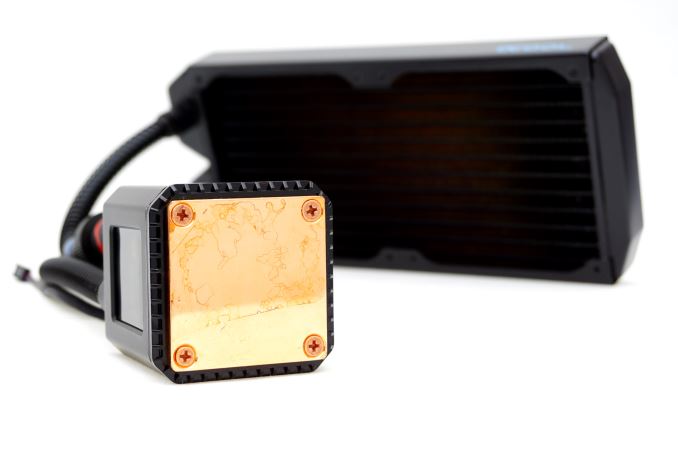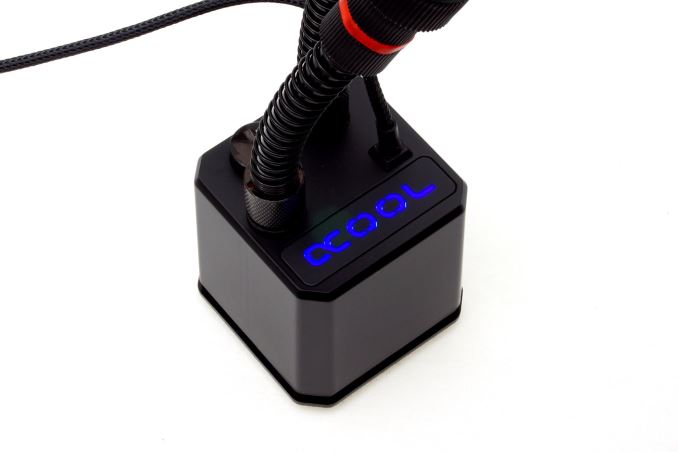The Alphacool Eisbaer 240 CPU AIO Liquid Cooler Review
by E. Fylladitakis on August 1, 2016 9:00 AM EST- Posted in
- Cases/Cooling/PSUs
- AIO
- Water Cooling
- Cooler
- Alphacool
Conclusion
In this review we had a look at Alphacool’s latest product and first AIO liquid cooler, the Eisbaer, which the company is marketing as an “extremely quiet, expandable solution”. It is true that the supplied 120 mm “Eiswind” fans did perform very well and that the ceramic pump is practically noiseless, making the Eisbaer 240 the least noisy AIO liquid cooler that we have tested to this date. Our only concern lies with the long term reliability of the fans, as while sleeve bearing engines are amongst the least noisy options, they lack the long-term reliability of other solutions that are noisier or expensive.
While the Eisbaer 240 did not outperform every other similar cooler in terms of raw thermal performance, it possibly has the best noise/performance ratio of every dual 120 mm fan AIO cooler available today. It could likely outperform several of its competitors if stronger fans were to be used, but we feel that Alphacool’s choice of fans in terms of noise performance hits the mark. Users can fall into two categories - thermal or acoustic performance, and a user that places acoustic comfort above a slim difference in thermal performance will do well here. Even with its quiet fans, the thermal performance of the Eisbaer is very good and more than adequate for the typical gamer/enthusiast that simply wants a cool and quiet high performance system.
The expandability of the Eisbaer 240 is one of the primary focus points of Alphacool’s marketing team. It is true that the Eisbaer 240 is very versatile, offering expansion options depending on the user’s skill and needs. It has a quick release connector on the tubing for users that want to keep things simple and expand using parts that the company supplies specifically for the Eisbaer, plus the company has simple tube compression fittings installed on every part that allow the user to completely remove the tubing if necessary. The Alphacool Eisbaer 240 practically is a standard, divisible liquid cooling kit that is being supplied preassembled and prefilled by the company.
Expanding the Eisbaer may be a relatively simple process but the user has to take into account the impact that the expansion will have on the performance of the system. For example, the insertion of a GPU block will add both resistance and thermal energy into the system, respectively reducing the flow of the pump and increasing the load of the radiator. A second radiator will offer quicker thermal energy dissipation but significantly burdens the pump. In theory, a single loop can be expanded to cover multiple GPU blocks and more than one radiator but, as the pump cannot be upgraded, we advise against the installation of more than three items per system. It is technically possible to add an external pump into the system but that would beat the purpose of having an AIO solution in the first place, as a customized kit would perform better and cost less at this point. Alphacool has informed us that they are currently designing a similar AIO liquid cooler for GPUs, the GPX-Pro. When the GPX-Pro becomes available, the interconnection between the two system will be possible, allowing them to share their radiators and double the pressure (but not the flow) of the pumps. Whether having the two systems interconnected will perform better than keeping them separated is a complicated discussion that depends on many specific details, such as the CPU/GPU, the position of the radiators, the strength of each pump, the usage of the system, etc., preventing us from being able to provide a simple and definite answer.
Alphacool currently retails the Eisbaer 240 in Europe for €115 incl. VAT plus shipping costs. Slightly lower pricing may be found via some of their local resellers. In the US, the Eisbaer 240 is available for $120 plus shipping. The price is higher than that of most similar competitive products, but reasonably so for a product that offers an expandable setup with a copper radiator and high thermal performance combined with near-silent operation. We highly recommend it to those seeking a low noise AIO cooling solution, especially when there is a significant preference for potential future expansions/upgrades.












69 Comments
View All Comments
ikjadoon - Tuesday, August 2, 2016 - link
This idea just doesn't die.Quieter and cooler and cheaper than a Noctua NH-U14S.
http://www.hardocp.com/article/2016/02/11/arctic_c...
Azune - Monday, August 1, 2016 - link
He should have said best noise/thermal performance for 240mm radiators. Because larger radiator and larger fans will always win in this metric. (H110 is a 280mm)BrokenCrayons - Monday, August 1, 2016 - link
Pass on the water cooling. I don't like the idea of mixing liquid and electricity for no tangible benefit over the HSF that was included in the box. Yes, sure the temperature of the processor is lower, but who cares really? As long as it's not above the manufacturer's spec, temperature makes literally no difference to me. I can understand wanting to cut back on noise and that might warrant an upgraded air cooler over the retail boxed one, but even then, a lot of the reasoning behind that ignores ambient noise of HVAC, other people, and blaring televisions which would drown out the relatively small amount of noise from a stock cooler.ikjadoon - Tuesday, August 2, 2016 - link
Why are you even reading this review? LOL. It's like a guy who drives a Camry walking into an aftermarket parts store: "A turbocharger? I don't like the idea of mixing more air. Sure, the horsepower is higher, but who cares really?"Wrong review and maybe even wrong website, dude. :D
BrokenCrayons - Wednesday, August 3, 2016 - link
What is it with men and comparing everything to a car? Is it really that ingrained into the brain wiring that guys who were given little toys to push around as toddlers that then grow into grade school students who drive imaginary cars down the hallway while making engine sounds with their mouths end up seeing their world as adults through the view of a windshield? Nah nevermind, let's not delve into psychology here, it'd be a waste of time.Anyway "dude," have you read many articles on this site? AT doesn't cater specifically to the audience you think it does and perceive that you fall within. In my opinion, that's one of the nice things about Anandtech. It's writers explore a wider range of technology in greater depth than do the dinosaurs of the desktop computer era that have yet to realize that overclocking and tinkering is now well controlled by hardware manufacturers that manage even that experience to the point where it's basically a walled off sandbox that only leaves buyers with the impression their extra expenditure is giving them something more rather than genuinely rewarding them with something worthwhile.
BrokenCrayons - Wednesday, August 3, 2016 - link
What is it with men and comparing everything to a car? Is it really that ingrained into the brain wiring that guys who were given little toys to push around as toddlers that then grow into grade school students who drive imaginary cars down the hallway while making engine sounds with their mouths end up seeing their world as adults through the view of a windshield? Nah nevermind, let's not delve into psychology here, it'd be a waste of time.Anyway "dude," have you read many articles on this site? AT doesn't cater specifically to the audience you think it does and perceive that you fall within. In my opinion, that's one of the nice things about Anandtech. It's writers explore a wider range of technology in greater depth than do the dinosaurs of the desktop computer era that have yet to realize that overclocking and tinkering is now well controlled by hardware manufacturers that manage even that experience to the point where it's basically a walled off sandbox that only leaves buyers with the impression their extra expenditure is giving them something more rather than genuinely rewarding them with something worthwhile.
JeffFlanagan - Monday, August 1, 2016 - link
I used to liquid cool and overclock, until a tiny leak destroyed a motherboard and CPU years ago.These days my PCs are so fast that I don't need to overclock, but if I wanted to, I wouldn't even try it unless the cooling liquid has a low enough boiling point to be MUCH more effective than air-cooling, like the liquid cooling used in some tablets.
Death666Angel - Monday, August 1, 2016 - link
"like the liquid cooling used in some tablets."You mean vapor chamber technology, which has been in use for several years in the PC space already and is in pretty much no way comparable to water based liquid cooling which is typically meant when talking about liquid cooling? Totally different technologies which shouldn't be conflated at all.
Death666Angel - Monday, August 1, 2016 - link
And I forgot to add to your "MUCH more effective than air-cooling" point. If you indeed mean vapor chamber technology, that is only effective in drawing heat away from the chips that create the heat. That heat needs to be transferred to somewhere where it can be taken out of the system (unless the heatsink attached via vapor chamver is literally the size of the wall around your room) and that is usually done via air cooling, i.e. having a lot of metal fins oriented in a way that a fan can push or pull air through them to cool them. So nothing magical about it.maximumGPU - Tuesday, August 2, 2016 - link
I'd appreciate if anyone can answer this:Can you make a custom loop cool better AND be quieter than a high end air tower?
Unfortunately I can only find contradicting opinions on this, anybody with direct experience cares to pitch in?